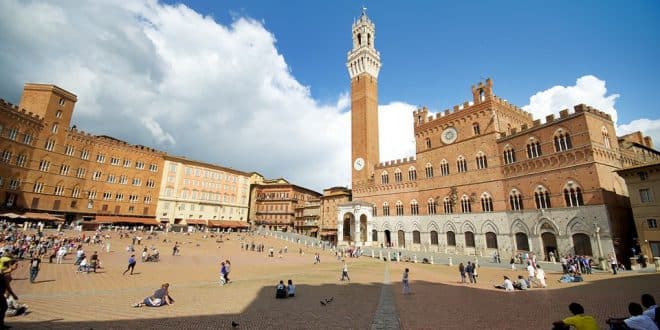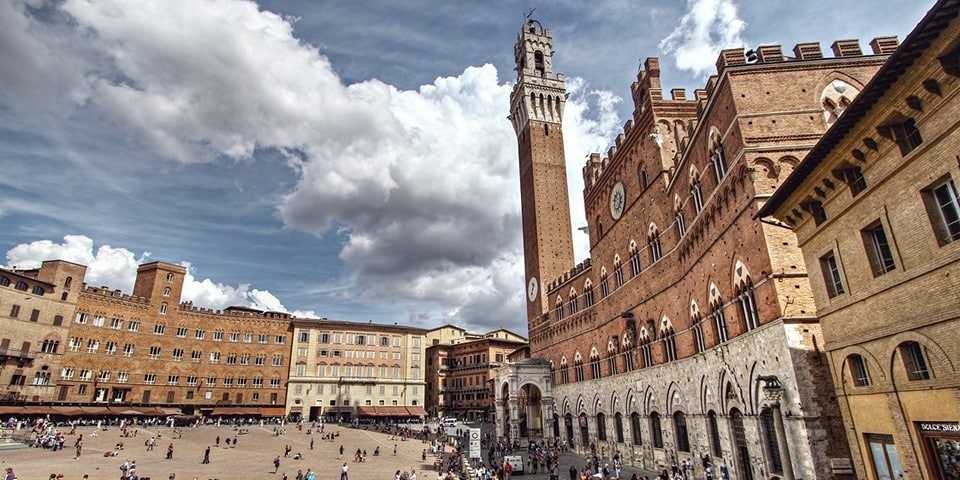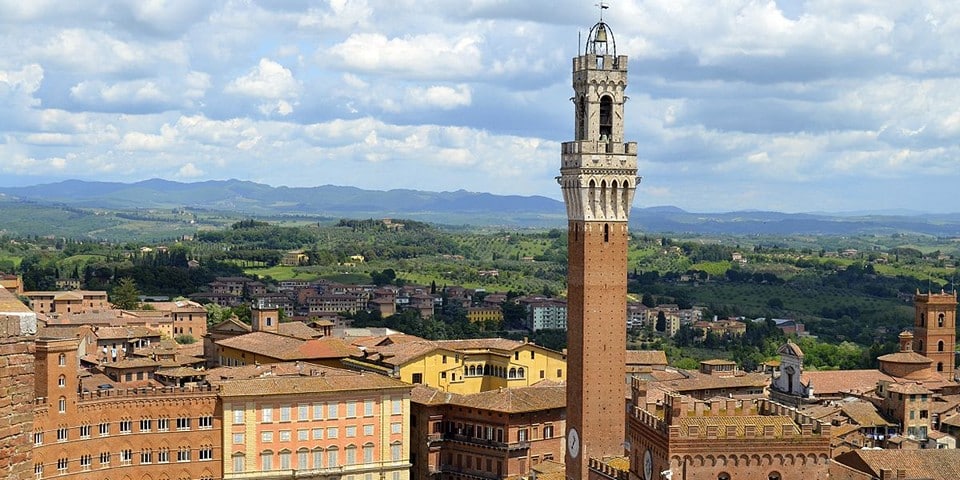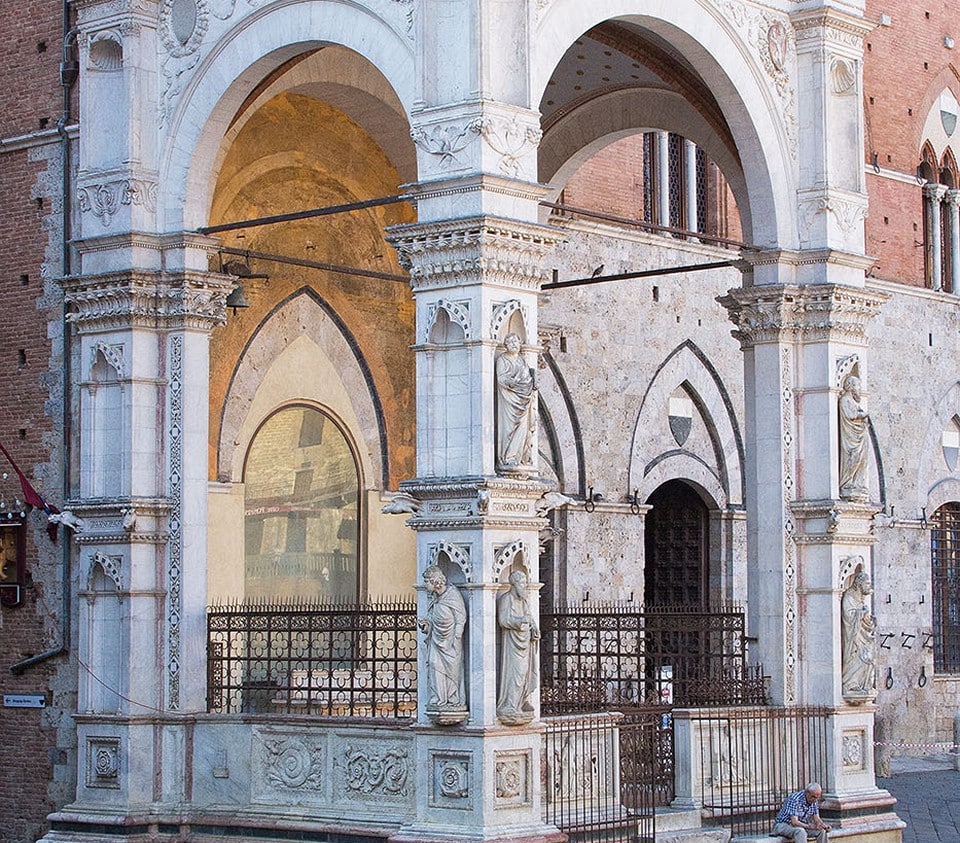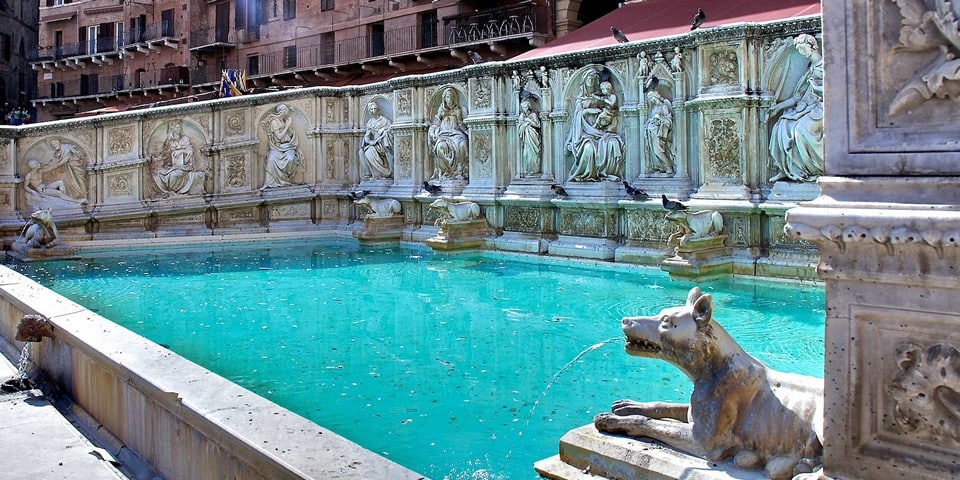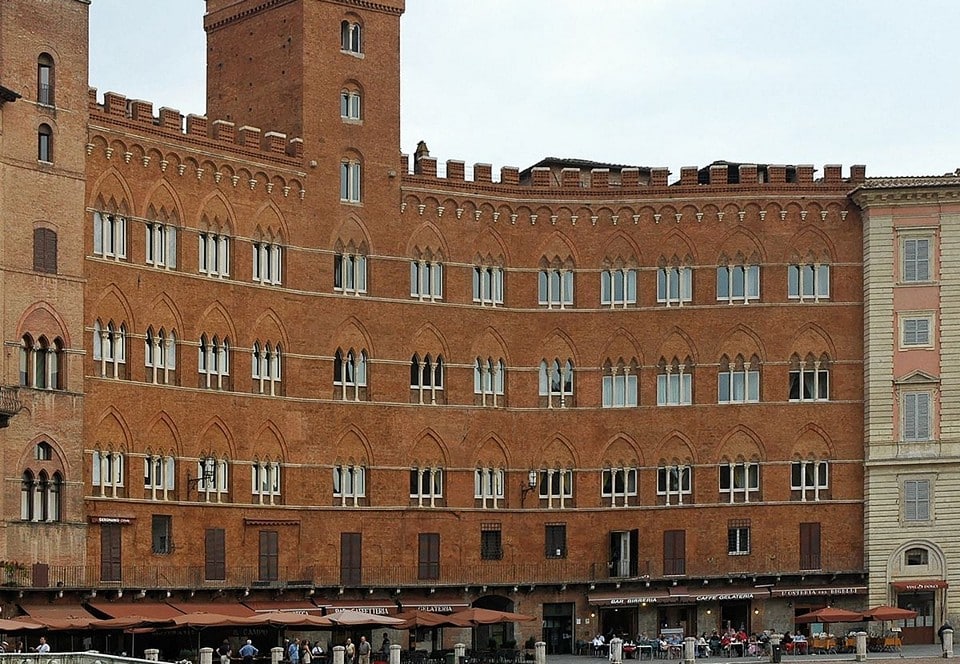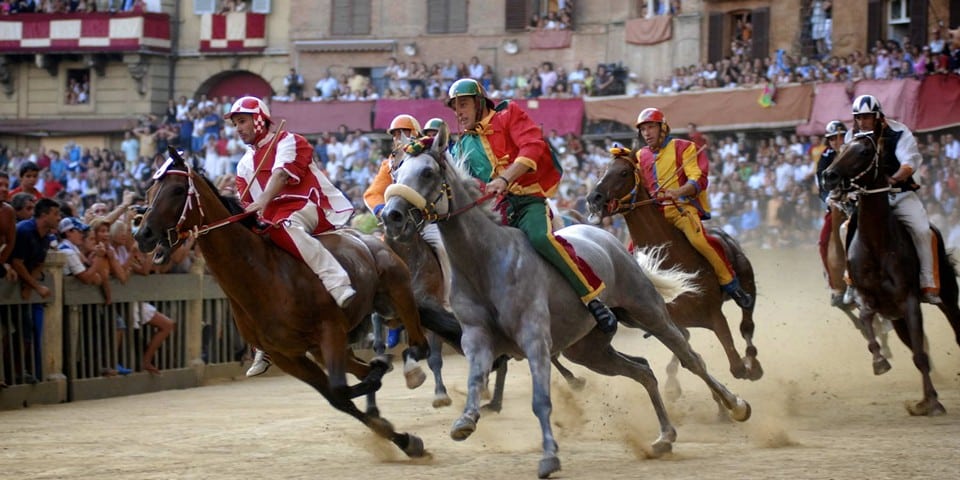The Campo Square in Siena has an unusual shape and a complex history.
Page Contents
The History of the Square
The first mention of the square in written sources dates back to 1169. At that time, Siena was a sovereign republic. Wool merchants and bankers ensured its economic power, and the Sienese denarius was an important European currency. The future Piazza del Campo was a crossroads of trade routes: south to Rome; west to the sea; north to Florence.
According to chronicles, the citizens cleared the field (Campo) in the valley of three hills. The hills were inhabited by the communities of Castellare, San Martino, and Kamollia, and turned it into a trading place. Thus, the “field square” – Piazza del Campo – was born, initially shaped like a funnel surrounded by hilly slopes. The height difference from the edges to the center was 5 meters. The residents of rival communities gathered here not only to trade but also to settle their disputes.
In 1193 a wall separated two squares: Piazza del Campo and Piazza del Mercato. The wall soon turned into “Bolgano” – a mint and Sienese customs. The development of Piazza del Campo was associated with the power of the “Council of Twenty-Four” – representatives of the wealthiest families of bankers (Tolomei, Salimbeni, Buonsignori, etc.). They were Ghibellines – supporters of the emperors in the struggle against papal authority, and the city’s bishop was exiled.
Golden times of Siena
During the rule of the “Council of Twenty-Four,” Siena experienced its “golden hour” in history – victory over eternal rival Florence in the Battle of Montaperti in 1260. But the independent-minded Sienese soon overthrew this government. In 1270, the “Council of Nine” came to power. A party of merchants-Guelphs, supporters of Florence and papal authority ran the city. Under their leadership, the former Campo turned into the residence of the government and the center of the city’s public life.
Palazzo Comunale
From 1288 to 1310, the “Bolgano” facade was expanded towards the Campo Square and transformed into the Palace of the Commune (Palazzo Comunale, Palazzo Pubblico). In 1327-1349, the tower known today as Torre del Mangia was built. At the same time, during the construction of the tower, the square in front of the palace was paved with red bricks. It’s divided into 9 sectors by strips of white limestone. The fan of sectors merged into a single point in front of the Palazzo Comunale, while the palace embraced the rest of the square with a semi-circular arc. Each sector represented one of the rulers of the Council of Nine and also served as a gathering place for two of the city’s 17 contrade (districts). The street communities – contrade – perpetually feuding with each other, set aside their militancy when occupying a place on Piazza del Campo.
Capella di Piazza
The White Marble Chapel (Capella di Piazza) appeared on the square as a gratitude to the Virgin Mary from the survivors of the plague epidemic in 1348. At the same time, a decree was issued by the City Council prohibiting the construction of houses protruding beyond the inner line of the square. The mansions of the Sienese nobility obediently surrounded Piazza del Campo, forming a smooth circular line with a length of 333 meters.
The Church of St. Peter and Paul, which disrupted the harmony, was demolished.
The Fountain of Joy (Fonte Gaia) – the final touch to the beauty of the square. It is named in memory of the feelings of the citizens. In 1409 they saw a spring of water gushing from the ground on the square.
Attractions
Each building on Piazza del Campo has its own history and serves as an essential element of harmony. The dominant feature is Palazzo Pubblico. It sets the style, order, and mood for the entire complex. The second most significant building is the palace tower.
Torre del Mangia
Torre del Mangia – a tower adjacent to the town hall – amazes modern builders. Standing 102 meters tall and made of fragile materials, it has stood for 500 years without collapsing. In the city chronicles, it is recorded that lucky coins are placed at the base of the tower for good luck, and stones with inscriptions of Jewish and Catholic prayers are placed at the corners – so it is not afraid of thunder or lightning.
The building is made in the Gothic style of red bricks, and the white limestone superstructure, like a crown, tops the structure.
In 1360, the townspeople installed clocks in the tower, and the 6-ton bell was replaced more than once, but it still does not produce a clear sound. The tower also had bad luck with its name. Its first watchman was a big eater and earned the nickname “Gourmand.” Thus, the tall tower, reaching high into the sky, became known as the “Tower of the Gourmand.” Tourists, paying 7 euros and climbing 400 steps, can enjoy views of the undulating Tuscan landscapes and the city panorama from a height of 88 meters.
Chapel di Piazza
The elegant loggia Cappella di Piazza at the base of the tower is a creation of three masters. The Gothic portico faced with marble was created in the 14th century by Giovanni di Cecco.
A century later, arches and columns in the style of the Renaissance were added. This delicate sculptural work was done by Antonio Federigi. Another hundred years later, the chapel was adorned with a fresco of Madonna with Child and God the Father by Antonio Bazzi.
Fountain of Joy
In 1419, the construction of a water pipeline in Siena was completed. Water flowed through multi-kilometer underground channels to Piazza del Campo and emerged from the ground as a fountain. Fonte Gaia – the Fountain of Joy. Now, a marble-clad pool by Jacopo della Quercia stands in this spot. The walls of the pool are adorned with reliefs of the Virgin Mary, biblical compositions “The Creation of Adam,” “Expulsion from Paradise”. Besides, it is complemented by pagan motifs of the feeding of Romulus and Remus by the she-wolf.
The townspeople were amazed by the sculptor’s work, and his name was left behind – Jacopo della Fonte. To preserve the valuable work of the master, it was placed in a museum, and a copy was left on the square.
Noble Houses
The palaces of aristocratic families in Siena, such as Piccolomini, Saracini, Buonsignori, encircle Piazza del Campo and form its decoration. The Sansedoni Palace is particularly impressive.
The terracotta building, in the best traditions of Sienese Gothic, united five noble houses. The wide facade has an elegant curve that follows the shape of the square. In architectural style, the Sansedoni Palace is remarkably similar to the Palazzo Pubblico. The tall tower above the Sansedoni palace was meant to balance the Torre del Mangia. But for safety they shortened it.
The Palio Horse Races
A blast from the passionate past that raged in Piazza del Campo during the Middle Ages comes alive in the form of Palio. Palio are the horse races between the contrade on July 2nd and August 16th. Each contrada, like a small state, has its own coat of arms, flag, allies, and adversaries. They prepare for the races in advance. All summer long, the participants dress in medieval costumes, parading with flags through the streets of Siena. The finish point is Piazza del Campo. Horses and riders receive blessings for the races at the Church of St. Peter and Paul.
On the day of the Palio, tens of thousands of fans gather inside the square. The capacity is 40,000 people… Imagine that such a number of people gether just for a few minutes of thrilling spectacle. Each participant must ride around the square three times – a total of 1 km – and reach the finish line. It’s not the riders who win (rivals can try to knock each other off in any way), but the horses, even if they reach the finish line without riders.
The biggest shame befalls the one who comes in second. The winning contrada receives a prize of 250,000 euros, and their flag hangs in the square until the next races. And Piazza del Campo returns to its leisurely life.
Time may leave its mark on the buildings of Piazza del Campo, but it can’t destroy the harmony that envelops every person who finds themselves here. The masters who created this architectural masterpiece out of the uneven terrain are truly admirable.
 Italy for me From Italy with love
Italy for me From Italy with love

